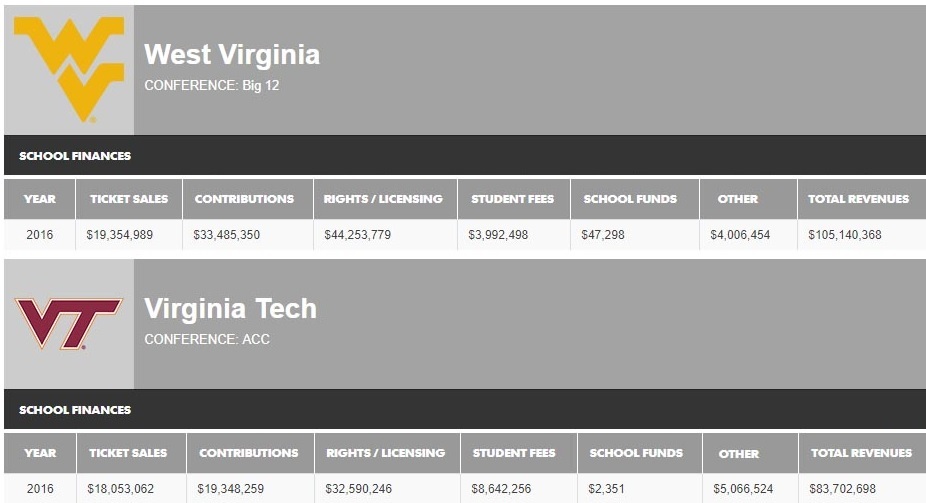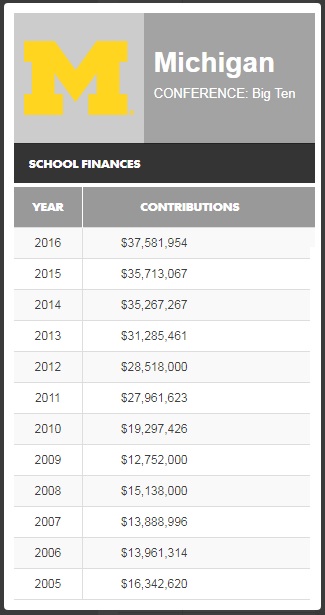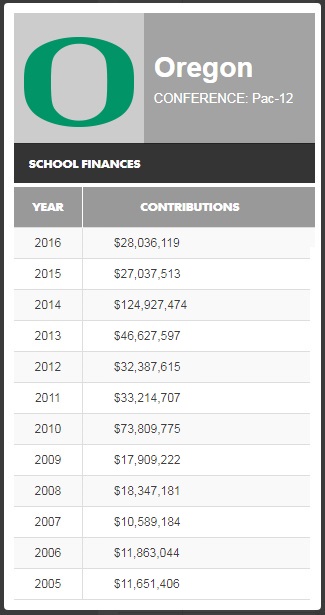Sponsored by the Drive for 25: The Hokie Club’s Drive for 25 campaign is a paid sponsor of TechSideline.com. As part of that sponsorship, we’ll be bringing you monthly updates and articles about the Hokie Club and the Drive for 25. To learn more about the Drive for 25, click here.
 Recently, while writing my article about 2016 Power 5 Finances, I noticed that in the USA Today NCAA finances database, you could click on any school name to find out more detail about that school’s finances not just in 2016, but dating all the way back to 2005.
Recently, while writing my article about 2016 Power 5 Finances, I noticed that in the USA Today NCAA finances database, you could click on any school name to find out more detail about that school’s finances not just in 2016, but dating all the way back to 2005.
When the article ran, some comments, both in the article itself and on the message boards, were aghast that West Virginia had a 2016 revenue figure of $105 million, compared to just $83 million for Virginia Tech. “How did WVU have $20 million more than the Hokies?” was the general question asked in multiple places.
So I screen-capped the details for both schools and created this graphic:
The graphic shows clearly how West Virginia far outpaced Virginia Tech in revenue. In 2016, WVU made $12 million more in Rights/Licensing revenue and $14 million more in Contributions. The Hokies made up some of the disparity back in student fees, but overall, West Virginia came out $22 million ahead in revenue.
The donation figure really jumped out at me, and it seemed like the next step was to record donation figures for every Power 5 school in the list and compare them to Virginia Tech.
The Pitfalls of the Donations Data (Don’t Skip This Section)
You have to be careful when comparing data in the USA Today reports, however. Randy Jones has been telling us for years in his annual financial reports that how schools report various financial figures varies, not just from school to school, but sometimes from year to year within the same school’s reports.
With regards to donation levels that Virginia Tech has reported over the years, Randy notes: “Contributions reported will not agree to the annual information reports from the athletic fund raising numbers because only the applications of those amounts are presented. If the funds are not expended, they are generally not reported in the NCAA reports.”
In other words, only the contributions that are spent are reported. So the Hokie Club might receive $25 million in donations in a given year, but if they only spend $19 million of that on scholarships and certain projects, then only $19 million is reported. Conversely, the Hokie Club could raise $23 million in a given year, but if, for example, a building project was finished and the Hokie Club made a large payment with funds that included money out of reserves, then perhaps a number like $27 million could be reported.
Looking at the reports from various schools, some schools’ contribution levels as reported are relatively steady over the years, like for example Michigan:
But then some schools gyrate around, like Oregon:
In the Oregon figures, look at 2010 ($73.8 million) and 2014 ($124.9 million!). It looks like those were years that Oregon spent a lot of Phil Knight/Nike money on certain building projects.
Then there’s Oklahoma State, who spent a lot of T. Boone Pickens money in 2006 ($211 million).
You can’t draw sweeping conclusions about donation levels based on just one slice in time.
So I took the time to put all the data for 2005-2016 for each school into a spreadsheet, and then to average the data for the years presented (there was one exception: Penn State, which only reported 2010-2016).
So, for example, Virginia Tech’s reported contributions from 2005-2016 were:
- 2005: $10,392,445
- 2006: $13,866,740
- 2007: $22,251,053
- 2008: $17,345,132
- 2009: $15,315,905
- 2010: $16,138,765
- 2011: $15,849,981
- 2012: $18,153,190
- 2013: $16,599,597
- 2014: $16,333,821
- 2015: $16,748,895
- 2016: $19,348,259
- Average: $16,528,649
I’m instantly suspicious about that data, because I know — though I can’t find the data recorded anywhere on TSL — that Hokie Club contributions exceeded $20 million for a number of years in the mid-2000s. I was able to find this TSL article that reported 2004-05 donations of $24.2 million, way above the $10.3 million figure included above. That gets back to the discussion above about how figures are reported.
Having said all that, I think the figures in the NCAA Finances database on USA Today do paint a relative picture of contribution levels across Power 5 schools, especially when you average 12 years of data.
So what does that data say about where Virginia Tech ranks among Power 5 schools in contributions? Let’s look.
Power 5 Contributions Data, 2005-2016
Let’s get straight to the data, in table form.
This table presents average contribution levels for Power 5 conference athletic programs from 2005-2016, as compiled from the USA Today NCAA Finances database.
Note: Penn State data is for 2010-2016; prior years were not available.
Schools not shown due to data not being available: Boston College, Duke, Miami, Notre Dame, Pittsburgh, Syracuse, Wake Forest, Baylor, TCU, Northwestern, Stanford, USC, Vanderbilt, Notre Dame.
Click on column headings to sort the data.
The figures presented are not totals for 2005-2016; they are per-year averages for each school. So, for example, Florida averaged $41.4 million in reported contributions each year from 2005-2016, ranging from (detail not shown) $26.9 million in 2005 to $58.1 million in 2015.
| RANK | SCHOOL | CONF. | YEARS | AVE. CONTRIBUTIONS |
|---|---|---|---|---|
| 1 | Oklahoma State | Big 12 | 2005-2016 | $45,024,857 |
| 2 | Florida | SEC | 2005-2016 | $41,419,795 |
| 3 | Oregon | Pac 12 | 2005-2016 | $36,366,736 |
| 4 | Texas A&M | SEC | 2005-2016 | $35,531,118 |
| 5 | Texas | Big 12 | 2005-2016 | $35,418,190 |
| 6 | Auburn | SEC | 2005-2016 | $32,323,392 |
| 7 | LSU | SEC | 2005-2016 | $30,263,628 |
| 8 | Georgia | SEC | 2005-2016 | $29,700,737 |
| 9 | Alabama | SEC | 2005-2016 | $29,065,750 |
| 10 | Virginia | ACC | 2005-2016 | $26,644,370 |
| 11 | Tennessee | SEC | 2005-2016 | $25,572,038 |
| 12 | Ohio State | Big Ten | 2005-2016 | $25,262,684 |
| 13 | Kansas | Big 12 | 2005-2016 | $24,642,386 |
| 14 | Penn State* | Big Ten | 2010-2016 | $24,633,312 |
| 15 | Oklahoma | Big 12 | 2005-2016 | $24,577,267 |
| 16 | Iowa | Big Ten | 2005-2016 | $24,134,348 |
| 17 | Michigan | Big Ten | 2005-2016 | $23,975,644 |
| 18 | South Carolina | SEC | 2005-2016 | $23,641,991 |
| 19 | Wisconsin | Big Ten | 2005-2016 | $23,637,961 |
| 20 | Florida State | ACC | 2005-2016 | $23,216,237 |
| 21 | Michigan State | Big Ten | 2005-2016 | $21,901,968 |
| 22 | Louisville | ACC | 2005-2016 | $21,565,839 |
| 23 | Texas Tech | Big 12 | 2005-2016 | $21,151,475 |
| 24 | WVU | Big 12 | 2005-2016 | $19,167,257 |
| 25 | Arizona | Pac 12 | 2005-2016 | $18,847,689 |
| 26 | Washington | Pac 12 | 2005-2016 | $17,991,023 |
| 27 | Illinois | Big Ten | 2005-2016 | $16,575,714 |
| 28 | Virginia Tech | ACC | 2005-2016 | $16,528,649 |
| 29 | UNC | ACC | 2005-2016 | $16,470,629 |
| 30 | Kansas State | Big 12 | 2005-2016 | $16,331,284 |
| 31 | Clemson | ACC | 2005-2016 | $15,964,687 |
| 32 | Arkansas | SEC | 2005-2016 | $15,884,411 |
| 33 | California | Pac 12 | 2005-2016 | $15,677,896 |
| 34 | Missouri | SEC | 2005-2016 | $15,490,344 |
| 35 | Kentucky | SEC | 2005-2016 | $15,071,660 |
| 36 | Purdue | Big Ten | 2005-2016 | $14,393,017 |
| 37 | Indiana | Big Ten | 2005-2016 | $14,106,750 |
| 38 | Nebraska | Big Ten | 2005-2016 | $12,826,879 |
| 39 | Georgia Tech | ACC | 2005-2016 | $12,661,149 |
| 40 | Oregon State | Pac 12 | 2005-2016 | $12,314,910 |
| 41 | Arizona State | Pac 12 | 2005-2016 | $12,195,328 |
| 42 | Ole Miss | SEC | 2005-2016 | $11,701,354 |
| 43 | Maryland | Big Ten | 2005-2016 | $11,450,235 |
| 44 | UCLA | Pac 12 | 2005-2016 | $11,447,202 |
| 45 | Iowa State | Big 12 | 2005-2016 | $11,128,714 |
| 46 | Mississippi State | SEC | 2005-2016 | $10,958,512 |
| 47 | Colorado | Pac 12 | 2005-2016 | $10,377,293 |
| 48 | NC State | ACC | 2005-2016 | $9,605,338 |
| 49 | Minnesota | Big Ten | 2005-2016 | $8,368,446 |
| 50 | Rutgers | Big Ten | 2005-2016 | $7,451,606 |
| 51 | Washington State | Pac 12 | 2005-2016 | $6,980,052 |
| 52 | Utah | Pac 12 | 2005-2016 | $6,572,169 |
Per those figures, Virginia Tech ranked 28th out of 52 Power 5 schools in average contributions from 2005-2016. The Hokies ranked 4th among ACC schools. That’s better than I expected.
Let’s put the figures above in some context. I calculated the total revenue averages from 2005-2016 as well, and the Hokies ranked 35th out of the 52 Power 5 schools.
Not too bad, right? But note that by 2016, Virginia Tech had fallen to 41st in total revenue among those 52 schools, as I noted last week.
And in 2016 contributions, the Hokies were 36th, below their 12-year average of 28th. So things are trending down, not just in total revenue (because ACC schools are getting killed by conferences with networks, as I remarked last week), but in donations as well.
Random example of things trending the wrong way: you might find it interesting that Clemson, known as a fundraising powerhouse, ranks below the Hokies in 12-year donation averages, coming in at $15.9 million to VT’s $16.5 million.
But from 2014-2016, Clemson reported total contributions of $75 million, versus $52.4 million for Virginia Tech.
The Importance of the Drive for 25 (and those per-seat minimums, too)
By the way, I think the $19.3 million in reported donations for 2016 is fairly accurate. In April, the Hokie Club reported record donations for FY2017 at about $33 million and noted that number was an increase of 65 percent over FY2016. Plug those numbers into your calculator, and you can back-calculate a figure of about $20 million for FY2016.
If the Hokies had raised $33 million in 2016 instead of $19.3 million, Virginia Tech’s total revenue for FY2016 would have been $97.4 million, catapulting Virginia Tech from No. 41 in 2016 revenue all the way up to No. 30.
That’s the kind of profound effect that simply donating can have.
There are certain revenue streams that aren’t going to change overnight, or even over the years. There are schools that have football stadiums that seat over 90,000 fans, versus Virginia Tech’s 65,000, and huge basketball coliseums versus Cassell Coliseum. The ACC Network, once it launches (don’t get me started on that), will make up some of the media rights revenue issues the Hokies have, but most agree the ACCN won’t be as lucrative as the SEC Network or Big Ten Network.
Phil Knight will always be an Oregon contributor. T. Boone Pickens is an Oklahoma State money fountain, and Kevin Plank and his $1.85 billion net worth will always be graduates of the University of Maryland (well, Kevin is; not his money).
Certain disparities will always exist. But if there’s one area where Hokie fans can have an immediate impact, literally overnight, it’s in Hokie Club contributions. If 1,000 Hokie fans decide to donate $100 a month to the Hokie Club — or $100 a month more — that’s $1.2 million in new contributions and revenue, without having to wait on, say, John Swofford to properly manage the ACC’s media rights.
The same thing happens if 2,000 Hokie fans decide to donate just $50 a month. And so on.
Writing these “Drive for 25” sponsored articles is an interesting exercise, from the standpoint that it can sound like I’m openly shilling for the Hokie Club. I admit that. But on the other hand, the numbers don’t lie, and while the statement “The Drive for 25 is critical to the future of Virginia Tech athletics” may sound like an opinion, I would postulate that it’s more fact than opinion. The more numbers I run, and the more I learn, the more I realize that.
The Hokie Club has rightly couched much of their recent work in terms of the Hokie Scholarship Fund, and the need to raise enough money to pay for athletic scholarships without having to dip into the operating revenue. But really, the Drive for 25 is a larger initiative that is about Virginia Tech athletics overall, not just scholarships, and is an effort to bring Hokie fans together to have a big impact on Virginia Tech’s success on the fields of play.
If you want to know more about how Virginia Tech compares to its Power 5 brethren across all revenue streams, check out this page I set up that enables you to sort schools by ticket revenue, contributions, media rights, student fees, and more. It’s interesting stuff:
Power 5 Finances, Per-School Averages, 2005-2016










 Print
Print







What irritates me with the new system,you have to give to the scholarship fund to get credit increases for parking location and ticket locations. If someone knows this is wrong, please let me know since the Hokie club officials I have talked with have confused me.
There are major points that many Hokies may have overlooked. Once the AD administration reneged on the lifetime club memberships, many people stopped giving. These are people that not only gave major contributions but these contributions back then went to the VT Foundation for capital projects. However, these contributions were counted toward their Hokie club obligations and not directly towards the Hokie club.
Now, you “can” contribute to the Foundation but if you want to get more bang for your buck, you better give to the Hokie club via the per seat contributions and ticket purchases. So for the major contributors that decided to continue giving, they are now giving directly to the Hokie club and not the Foundation.
In an effort to instill upon the masses that this administration made a good move with their decision to eliminate the lifetime club memberships, they are reporting major increases in giving to the Hokie club. Are they comparing apples to oranges? They say they saw an increase in memberships, I wonder if they are still counting me as a member?
I remember on air TV discussion years ago about baseball attendance at Kansas City home games. The Royals were winning, but couldn’t sellout their 45,000 seat stadium.. Yogi Berra created another one of his famous “Yogi-isms” when he said, “If the fans don’t want to come out to the ball park, how’re you going to stop ’em?”
If Virginia Tech fans don’t give enough, how are you going to change giving habits? I belief it is cultural. I’ve heard the same pathetic refrain for 50 years, with the obligatory and standard reference to IPTAY at Clemson. It falls on deaf ears. And you don’t change culture overnight.
To me it’s disgusting that all the rich elite in Hooville will reach in their pocket to throw money in the offering plate without asking what it’s for. I am reminded of Lowell’s “The Vision of Sir Launfal” where the young knight in his young exuberance to seek the grail gallops forth on his steed across the drawbridge, only to be accosted by an unsightly beggar, to whom the young knight scornfully tosses a couple of coppers, as if to say, “get out of my sight you loathsome thing, can’t you see I’m on a glorious quest?” After years of searching the aged knight returns home to find the beggar still in his accustomed place outside the castle walls.
Which culture is worse? Virginia’s scorn of money, or Tech’s being cheap? Either way, change does come quickly. As I said, I’ve been waiting for the bus for 50 years.
UVA grads give more money because it’s part of the culture of the university and alumni base. They’ve always been aggressive in their fund raising. I graduated in 76. I worked with a Hoo right out of school and was impressed with the amount of simple fund raising material he regularly received from UVA compared to what I got from Tech. They were more savvy about their emotional appeal that made alums feel their alma mater was a special place creating a culture where they wanted to help.
Unfortunately Tech has never had that culture. Too much was based on ” What do I get for my donation”.
I sense it might be changing, but generally Hokies are, to be frank, cheap. I know plenty of very successful Hokies who won’t give the school a lousy 100 bucks a year. I’ve shamed a number to give that and after a year they stop. It’s just sad.
I think the seat fees are a shot in the arm, but if the program goes stale again as it did in 2012-2013, I suspect Tech fans will bail very quickly. Let’s hope that we don’t have to find out if that’s true
Are they actually cheap? Or were they “raised” in an environment that wasn’t conducive to creating an alumni base that knew to give and was persuaded to give?
That washed 15 years ago. But with the explosion of social media and the information that’s now available, that’s no longer an excuse. I’m in noVa and know many many Hokies up here who have done well in life…..are huge Tech fans yet wouldn’t give the school a dime. It’s shameful.
First off, I think Hokie Club is doing a great job with the Drive for 25 effort. Three things they still need to combat:
1) people think you have to be a big money donor to donate. You don’t. You can join for as little as $8.33/month.
2) only season ticket holders donate. Not true. Plenty of people donate who don’t have tickets or any other direct benefit.
3) Hokie Club members are older alums. I think this is a huge issue. HC needs to get students and recent alums on board with low donation amounts ($8.33/mo)
Drive for 25 has been fantastic but there’s still a ways to go.
4) VT employees who feel they are already shafted by the university with their, on average, less than market value salaries. I have spoken with several colleagues who generally feel they can’t give $100/year because they are underpaid as it is.
5) Recent/new alums who are struggling to make tuition payments and can’t afford to donate.
Unfortunately I don’t see any good way to incentivize from the university’s side without hurting themselves, especially since most student loans are private or federal.
I think students with hefty loans get a pass. There are plenty of NOVA kids who had mommy and daddy pay for school who don’t give a dime and they are making six figures. Where are their Hokie Club donations?
If our > 250,000 living alumnae contributed $100/yr. to our athletics that is an increase of $25,000,000.00/yr.
We need to do a better job communicating to these folks of just how critically important it is to our University that we donate. The ripple effect extends outwards and touches every corner of our campus!
p.s., not to mention reaching out to those in the New River and Roanoke Valleys. Alum. and non-alum. alike. We are all in this together and we need to push and pull as hard as we can.
There are diminishing returns but a positive correlation exists between the support behind the scenes and success. I have eight first cousins that graduated from W.V.U. and they are freaks regarding support for their school. Their passion is deep rooted. We are going to rumble in a few weeks and I remember when I was young how hard V.P.I. played them. A black-sheep thing. Now that roll has flipped. We better be ready!
If our > 250,000 living alumnae contributed $100/yr. to our athletics that is an increase of $25,000,000.00/yr.
That statement right there should be all that is communicated to the 250K alumni.
Very simple equation yet most people and organization take too many words to say it.
Sad…we (collectively) TALK a good game…that’s about it
Light’en up Francis! Hokies are not Lemmings led over a cliff or Sheep led to slaughter and we dont have a T-bone or Phil K in our backyard…we earn every penny and expect things are done right…that will NOT get you to the top in this day and age when others will cheat and misrepresent facts every chance they get…
GO HOKIES…Be STRONG…Be HOKIE!
What does THAT have to do with anything? I know we don’t have a Phil Knight or T Boone. Take them AND thee cheating schools rout of the equation and we are STILL anemic in giving. It is mostly the NUMBER of people who give, not the amount.
Also, every school whose fans support them thru donations are not cheating. That is a handy excuse. Of course it happens, probably way to frequently, but that doesn’t let us off the hook. We SHOULD continue to do it the right way, despite the fact that it will keep us at a disadvantage. We have a lot of people who DO contribute (just proportionately far too few). That is my point…West Virginia??? Really?? Middle of the pack in donations?? Really?? I stand by what i said
Is there any information on what percentage of AD employees are contributing members to the Hokie Club? Just curious. I was involved in a fund raising project for a non-profit organization and the first thing we did is have everyone involved contribute something so we could say we had 100% participation.
Great suggestion and idea !
If I read your table right UVa #10 overall and #1 in ACC. Hasn’t helped football much.
So can someone (Will?) explain exactly why/how UVA is pulling in that kind of money??
Doctors and Lawyers
Yep. Not just new money grads, either. Lots of old money.
seems like some old and new hoo-alumni need to ask for big refunds. and stop throwing money into the bottom of the football pit.
comparatively speaking we are a huge bargain, even though our Olympic sports are just coming into their own. we’re making our measly Abe$ sing, squeal, and shout Hallelujah! compared to how many P5’s are wasting their Franklin$.
we still have a long way to go. we all need to step up our giving, attendance, and alumni recruiting because we obviously have so much untapped potential.
if you’re reading this and are not a Hokie Club member: please reread the article and step up.
if you’re just beginning, and want to try to keep up with klempsun’s IPTAY, then start off with $10.
if you think we deserve better then $110 for 110% (Campaign) Hokies is a fine start.
if you can donate more, pick your comfort level and stretch up a little more. those sec, b10, and even those homely ‘eers have been at it for some time; and we have some ground to make up.
got a favorite sport(s) – you can designate your gift$ and begin to feel like you own a little more of that one than the rest of us.
please, just start giving.
please, keep raising your contribution each year or when you can.
please, attend as many Virginia Tech events – alumni, educational, athletic, social, and cultural – as you can.
please, participate in Hokie Club events. and
please, keep the VT conversations on the sunny side.
Go Hokies!
Med and Law grads=more $$$$. Not sure that can be overcome.
Yet we touted a few years ago the data that said the average VT grad, 10 years out of school, made more than the average UVA grad.
But yes, it could be skewed data with UVA having some VERY rich, and some starving poets, while VT tends more toward the average….and perhaps very rich give more to make up for the lower earning average.